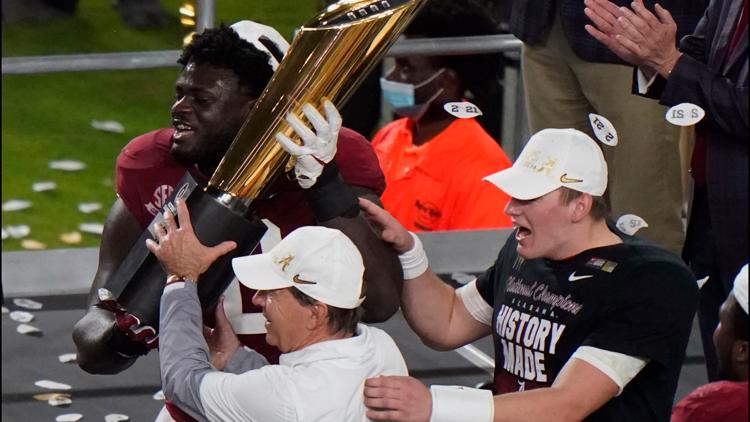JACKSONVILLE, Fla. — Take a moment to remember your fondest college football memory. Maybe it was your team winning the national championship or steamrolling your rival during Thanksgiving Day weekend. Or maybe it is less specific, like the thrill of a fall Saturday watching conference foes compete for little else than pride and bragging rights.
Hold on to those memories because you may not recognize college football in a few short years.
It is rare that an offseason completely changes the landscape of a sport, but in these trying times, maybe it would surprise no one that 2021 is that offseason.
In only a two-month span during the summer, three major developments could possibly change everything we know about the sport:
- Playoff expansion to 12 teams
- Players now legally benefitting from name, image and likeness (NIL)
- Texas’ & Oklahoma’s inevitable move to the SEC
In any other off-season, either one of the three stories would dominate the college sports news cycle for months. But as this season prepares to kickoff, fans are trying to catch their breath before trying to prepare themselves for another roller coaster of a season with COVID-19 as a backdrop.
On June 10, the news broke that the College Football Playoff was looking to expand from four teams to 12. While many fans and people who cover the sport expected playoff expansion, few expected the jump to 12 teams.
This playoff would include the top 6 conference champions plus 6 at-large bids. There will be no distinction between Power 5 and Group of 5. Under the proposed system, the PAC 12 would still be left out of the 2020-21 playoff, in favor of the champions from the AAC (Cincinnati) and Sun Belt (Coastal Carolina).
Notre Dame, BYU, Army and any other independent school would also not be eligible for automatic conference champion qualification.
Confused yet?
The proposal would give the top four teams a first-round bye while the remaining eight teams play in first-round games at the higher-seeded team’s home stadium. Then, the eight teams that remain will play in bowl games in the quarterfinals and semifinals followed by a neutral-site national championship game.
In other words, if you’re a fan of bowl season, this system is not for you. However, if it works for the NFL, it must work for college…right?
If you thought that would be the story heading into the off-season, no one would blame you. But in late-June, the NCAA formally announced that all college athletes could seek out paid endorsements, reversing its ancient rule on name, image and likeness.
Within days, players signed endorsement deals worth tens of thousands and even hundreds of thousands of dollars. Notably, Alabama’s Bryce Young, who has yet to play a meaningful snap a quarterback and has not officially been named the starter, was making $800,000 in endorsements, according to Coach Nick Saban.
While the decision was celebrated by most, particularly former players and media, it also led many to wonder if there was even a need for the NCAA anymore with the outdated amateur college athlete model now, for all intents and purposes, dead.
Much of the criticism for this issue went towards NCAA President Mark Emmert. The criticism focused on his continued defense of the amateur model, where athletes could land in major trouble with the NCAA for signing an autograph for $5 while the NCAA and universities made billions in television contracts. Some speculated his decision making and actions in the Ed O’Bannon lawsuit started the slow process leading to the NCAA’s doom.
As athletes inked deals for the first time, there was still another bombshell story to come, one that could lead to the full-on collapse of college football as we know it.
On July 21, the Houston Chronicle broke the story that Oklahoma and Texas, the two most prestigious football programs in the Big 12, reached out to the SEC about joining the league. Once the story broke, all others seemed to be of little consequence as schools and conferences prepared for the possible fallout.
On the surface, it’s a bad competitive move. The two schools would move into the most competitive conference in college football. They would lose traditional rivalries, most notably the Bedlam game between Oklahoma and Oklahoma State. They would not wield the unrivaled power they held in the Big 12, where a common punchline was that the Big 12 commissioner never made a decision without consulting Texas first. In fact, among SEC fans, the two blue blood programs would likely fall behind some of the conference’s elite in terms of prestige.
Yet, the almighty dollar speaks volumes. The SEC distributed about $45.5 million to each school from its $729 million in revenue during the last fiscal year, according to USA Today. Compare that to the $34.5 million distributed to the Big 12 schools last year, according to the Associated Press.
For us average folks, $34 million is a ridiculous amount of money of which most people cannot comprehend. But the schools borrowed the old adage: “A million dollars here, a million dollars there, and sooner or later it adds up to real money.” And to these programs, the $11 million in distribution that separates the SEC and Big 12 is real money.
Events accelerated and only a few weeks after the initial story broke, both Oklahoma and Texas accepted an invitation to join the SEC in 2025, when the Big 12’s current television contract ends.
With those two schools set to join the SEC, college football insiders and fans pitched a wide variety of scenarios for the future of the Big 12 and other conferences:
- The Big 12 would invite schools from Group of 5 conferences like UCF and Cincinnati to replace the outgoing Oklahoma and Texas
- The Big 12 and Pac 12 or AAC would merge and form a “super conference” of 20 or more teams
- The Big 12 folds and the eight remaining schools would be picked up by other conferences.
- The Big 12 and Pac 12, who have struggled to remain nationally relevant in the College Football Era, would both fold leaving the SEC, Big 10 and ACC to form their own “super conferences.”
In light of both the name, image and likeness reversal and the Oklahoma/Texas move, there has been talk of the remaining conferences leaving the NCAA to form their own governing body with their own commissioner.
By the way, I didn’t even mention the Supreme Court decision in which Justice Kavanaugh declared the NCAA “is not above the law.” Nor did I mention the ongoing decision on COVID-19 protocols for both teams and stadiums. I even left out a rumored alliance between the PAC 12, Big 10 and ACC.
As I reflected on all the news that has happened since the Crimson Tide beat Ohio State in the national championship, I took out my Magic 8 Ball I got for Christmas in the 2nd grade. First, I asked if college football is going to be radically different in five years. Every time, it tells me “Yes Definitely.”
But then when look into my crystal ball to see what that might look like, I can only see me screaming in front of a television screen because the blind referee called a pass interference for love tapping while my neighbors file a noise complaint with police.
The truth is, whether we as fellow college football fans like the changes or not is irrelevant. There is too much money at stake, and for the people who run the sport, money is the bottom line. The traditions, rivalries and fan enthusiasm are secondary, and that’s putting it generously.
The truth is, the powers that beat also looked into my crystal ball and saw the same prediction for me and every other college football fan: I will still wake up on Saturday morning, watch College Gameday, root for my team to win by 40 points and pull for the 2-8 team who is definitely going to upset my rival.
I’m then going to call my friends and family, who were also watching the game, and laugh or curse about the day’s drama.
So take my advice on this one: Debate, argue, call into Paul Finebaum and rant about the offseason while you still can. But when your eyes see foot meeting leather for the first time on a Saturday afternoon, take a deep breath and relish every minute of every game you can.
Matthew Copeland is a digital producer at First Coast News.



